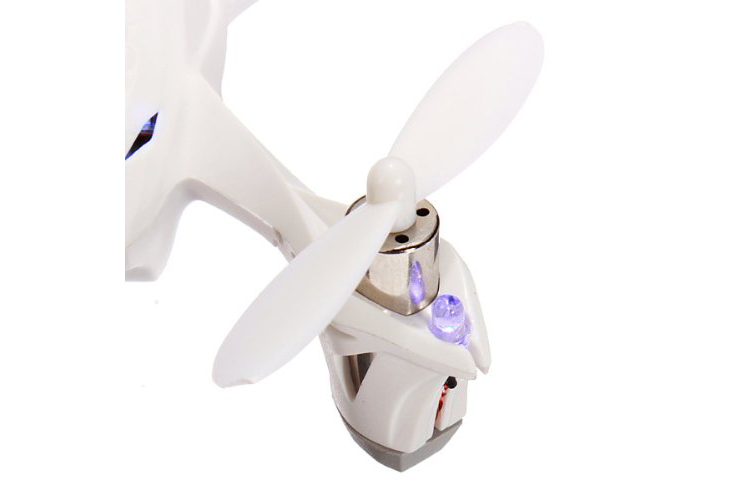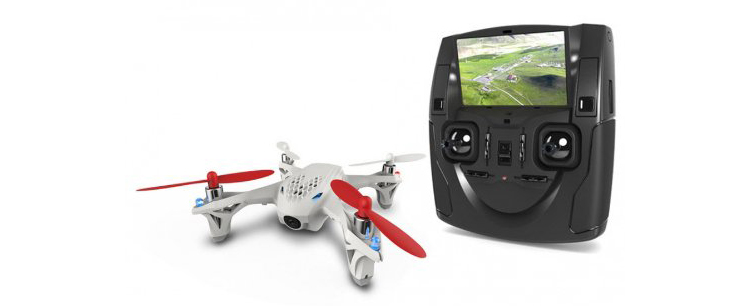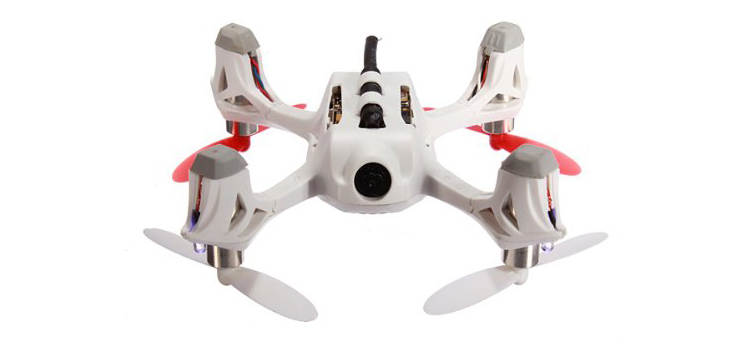Hubsan FPV X4 Review: The Beginner's Racing Drone
Our Verdict
Aspiring drone racers will love the speed and maneuverability of the X4, besides every bit the cheap replacement parts.
For
- Fast and like shooting fish in a barrel to fly
- Very maneuverable
- Big screen gives pilot first-person view
- Spare parts are cheap and easy to install
Against
- Lackluster video quality
- Must process video before editing or uploading
- Short video signal range
Tom's Guide Verdict
Aspiring drone racers will dear the speed and maneuverability of the X4, as well every bit the inexpensive replacement parts.
Pros
- +
Fast and piece of cake to fly
- +
Very maneuverable
- +
Large screen gives pilot start-person view
- +
Spare parts are cheap and easy to install
Cons
- -
Lackluster video quality
- -
Must process video before editing or uploading
- -
Brusque video bespeak range
Drone racing is a thrilling new sport where pilots transport high-powered drones careening around courses at high speed, occasionally crashing spectacularly. The drones the pros apply aren't cheap, costing hundreds or thousands of dollars. Fortunately, the popularity of drones ways that you don't need to spend that much to go a taste of drone racing: a $120 drone similar the Hubsan X4 H107D FPV is expert plenty to meet if you accept what information technology takes to be king of the drone track.
This speedy drone has a lot of ability and maneuverability, packed into a tiny case that is cheap to fix when you crash (and you lot will). The quadcopter has a small camera on board, and a screen on the controller shows the video for a first-person view (FPV) from the drone. For the full racing experience, the controller besides includes a video output so you tin can connect it to an FPV headset, such as the $600 Avegant Glyph, which really makes y'all feel like you're pod racing on Tatooine.
Pattern
The four.seven x 4.half dozen x 1.25-inch X4 is pocket-sized, just the compact plastic case packs a 380mAh lithium polymer bombardment, a small camera and ii radios — a 2.4-GHz radio that connects the drone and the controls and a 5.8-GHz radio that beams the video preview to the airplane pilot.
The quadcopter feels very dense, weighing 1.five ounces when it'due south ready to wing. The end of each arm houses a motor too equally blue and red LED lights that bespeak the orientation of the drone. These lights indicate the status of the drone, besides as aid you lot find it in low low-cal. When the drone is connecting to the controller, the front bluish LEDs blink. When the drone is ready to fly, all of the LEDs are solidly lit. When the battery is running low, all of the LEDs offset to blink equally a warning that you demand to land.
The lens of the camera sits on the forepart of the torso. Information technology captures low-resolution 720 ten 240-pixel video or 2-megapixel stills. The battery fits onto the dorsum of the drone body, sliding between the electronic components. There is no on/off switch for the drone: you lot power the X4 on by connecting the battery cable, unplugging that cable to turn it off.

4 2.ii-inch rotor blades fit right onto the motors, held in place by friction. The ii orientations of rotor are indicated by letters on the blades themselves: A for clockwise and B for counter-clockwise. Some drones that apply a tight fitting rather than a bolt or screw tend to lose their rotor blades when they popular off during crashes. That didn't happen with the X4; the rotors stayed on the many times I crashed the drone.
More: Best Drones
If you are concerned most the rotors injuring someone or something, an included prop guard with a protective plastic rail fits onto the motors. Just for serious racers, this will create some serious drag on your speed.
The X4 is small and light enough that it doesn't need to be registered with the FAA. The pocket-size size and weight also makes it relatively safe, as it'due south unlikely to injure anyone if it flies out of control.
Controller
The controller that comes with the X4 is rather large compared to the drone itself. At about 7.five x vi.25 ten 3 inches deep, the controller is a sizable clamper of plastic to carry around. But unlike the drone, the 1-pound controller feels light for the size, like it is mostly empty space. Information technology's contoured to fit in the hand, with two grips on the back. That's important, because, without realizing it, you tend to throw the controller around a lot when flying at speed, especially when using an FPV headset.

The main feature of the controller is a large 4.iii-inch LCD, which shows both the video preview and flight information such every bit the battery level of both the quadcopter and the controller. Information technology too displays a timer for how long the controller has been turned on, and offers access to the on-screen carte du jour of settings. The screen has a fairly low resolution, but it is brilliant and remains visible in all but the brightest directly sunlight.
You access the settings menu past pressing the correct stick in for a second. That brings up features such equally video playback, stick sensitivity and orientation and controller/quadcopter frequency. The latter is important if you are at a competition or are sharing a space with other fliers, equally it means that each pilot tin can option a different frequency in the 5.8-GHz frequency ring that the X4 uses to ship video back to the controller.
MORE: Drone Racing: How to Get Started
On the correct side of the controller, you'll discover a microSD slot, used for recording photos and video, merely you'll take to bring your ain carte du jour. The X4 can record video to SD, SDXC and HDSC cards upwardly to 32GB in capacity. The low-resolution video captured by the X4 means small file sizes, so memory card chapters isn't a major upshot: a 4GB card could concur several hours of video. On the left side of the controller are ports for outputting analog audio and video to feed into an FPV headset.
Flying
In that location is a lot of power in the X4, which translates into speed and maneuverability. But even though the drone can reach speeds of up to 10 mph, its power remains mostly under your command since the quadcopter responds quickly to the control sticks. The sensitivity level for these ranges from normal to proficient, with the latter making the controls more sensitive, so any slight twitch of the control sticks volition effect in the drone moving. The controller defaults to the normal setting.

Pressing the left control stick sets the X4 into flip fashion, where moving the right stick will make the quadcopter flip in the indicated direction. Similar near minor drones, this maneuver requires a decent amount of space, as information technology needs at to the lowest degree v to 6 feet of vertical space to recover. Attempt it any lower than that, and the drone will likely crash. Pressing the left stick in again exits the flip fashion.
Photos & Video
The X4 captures both photos and video, but you shouldn't expect much: the video is depression in both resolution and quality. The drone records footage at 720 ten 240 pixels, a slightly nonstandard resolution, and is rather blurry and soft. (Think cellphone video from several years agone.) The video is also decumbent to glitches acquired by signal loss or interruptions, which show upwards as black lines on the preview, or the occasional jump in the mostly smoothen video preview.
There is a lot of ability in the X4, which translates into speed and maneuverability.
We constitute that the video preview was more often than not reliable out to virtually 25 to 30 feet abroad, which gives you lot a decent amount of space to fly in. Whatever farther than that, though, and the video begins to pause up, speedily condign unviewable. More expensive racing drones offer larger ranges, thank you to more powerful video transmitters.
1 interesting and unusual feature is the X4's ability to play back video on the controller, which you tin do from the on-screen menu. This could be useful if yous are practicing a maneuver and desire to effigy out what went wrong, or if you got information technology right and desire to show it off.
Because of that 720 x 240-pixel resolution, video does require some processing before you tin edit or upload information technology to the cyberspace. Although the footage looks fine on screen (or through an FPV headset), clips you watch directly off the memory card look squished, since information technology's one-half the usual vertical resolution. A program such as Freemake Video Converter tin quickly set up this, doubling the vertical resolution to the more usual 480 pixels to produce an image that looks like a high-definition Tv image. Yous aren't probable to mistake this for video from a more expensive HD-camera-equipped drone, though.
More: Axis Vidius Drone Review - Tom'southward Guide
Starting time Person Viewing
The controller for the X4 includes an analog video output. That means the video betoken can be fed into a headset designed for drone racing, or any device that tin handle analog video, including an analog-to-HDMI converter or a headset such as the Avegant Glyph. The X4 can also piece of work with FPV video headsets that tin can wirelessly receive the 5.8-GHz video that the quadcopter sends, which includes the Fat Shark Spectrum Teleporter. That's important, because whatever signal processing steps between the drone and the pilot innovate a slight delay, which can mean the difference between successfully making a turn and crashing.
Bombardment Life
The X4 doesn't have an especially long battery life: We measured it at about 6 minutes. That'south a couple minutes shy of most other modest drones. But the minor lithium polymer bombardment holds simply 380mAh of juice, and then that isn't a large surprise.
The X4 captures both photos and video, just the footage is low-res.
When the bombardment is running low, all the LED lights on the quadcopter start to flash, and yous have about twenty seconds earlier the motors will cut out and the quadcopter will state (or crash, depending on where you lot are). These batteries are inexpensive and widely bachelor, though, costing just $20 for six, complete with a charger that tin can handle four at once. The X4 comes with a USB charging cable and a unmarried battery, which takes about xxx minutes to recharge from a standard USB port.
Repairability & Parts
Crashes are pretty much inevitable with a drone like the X4. Sooner or afterwards, sending this matter careening around is going to end with an unplanned run across with a tree, the ground or another drone on a racetrack. Then, like whatsoever racing drone, the X4 needs to exist quickly, cheaply and easily repairable, and it succeeds on all three counts. Swapping out components — including the rotors, the case and even the motors — is simple. The rotors popular right off with the included tool, and are like shooting fish in a barrel to replace. All of the components are pretty cheap every bit well; four new sets of rotors cost just $half-dozen, a new case is $6 and a gear up of new motors is just $10. It's even cheaper if yous buy a crash pack, which includes two sets of rotors, example, motors and a couple of spare batteries for $21.
MORE: What the FAA's Drone Rules Mean for You
Bottom Line
The Hubsan X4 H107D is what those in the drone racing circuit telephone call fix-to-fly (RTF), because information technology's not designed to exist tweaked and it makes for a good gear up of training wheels for beginning pilots. Overall, it's a lot of fun to wing, offer serious speed and maneuverability in a small, cheap package. Spare parts are cheap, which is important for a drone like this that is going to crash a lot. The video quality will practise for capturing your races in a offset-person view, merely don't expect crisp footage.
If you lot want sparkling video quality, splurge on a drone like the DJI Phantom iv ($1,399). Only if you lot want a drone that allows you to experience the thrill of racing without laying out a fortune, the Hubsan X4 is the way to get.
Source: https://www.tomsguide.com/us/hubsan-fpv-x4-drone,review-3613.html
Posted by: vujume1956.blogspot.com


0 Response to "Hubsan FPV X4 Review: The Beginner's Racing Drone"
Post a Comment